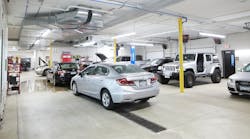Is there an OE/aftermarket partnership down the road?
CHICAGO — The Toyota exec’s message to the aftermarket was crystal clear: “We look forward to working closely with you.”
James Press, executive vice president and COO of Toyota Motor Sales, USA, Inc., believes automakers and the aftermarket need to share this proposed partnership “from the cradle to the grave.”
Or so he disclosed to attendees of May’s Global Automotive Aftermarket Symposium in Chicago, in what some might define as a kumbaya moment for the ages.
“There’s plenty of business out there,” said Press, who believes Toyota will need to rely on the aftermarket to handle the maintenance and parts needs of a booming generation of drivers, who will comprise a “Golden Age.”
Especially as it pertains to hybrids, which Toyota foresees will number at least a million by 2012. Though hybrid engines require less maintenance than those systems that run on gasoline, OEs like Toyota cannot fix all of these and other types of vehicles in subsequent years.
“We need your help, and it’s a big opportunity,” said Press, who considers all automotive companies as one united industry that needs to define itself as “one” for the benefit of the customer.
Expressing doubt, an attendee asked Press about what he perceived as Toyota ads that are negative toward aftermarket channels.
“There’s tension because we have to compete,” answered Press, who equated the situation to baseball teams. “The teams compete on the field, but the owners work together for the benefit of baseball.”
But if there are negative ads out there, he added, those messages would have to be reconsidered by the auto manufacturer.
Another aftermarket opportunity presents itself in the form of Toyota’s Scion, a vehicle aimed at the trendsetting youth market, which stands to heavily accessorize at the dealer level.
With a choice of up to 60 aftermarket accessories and parts, customers can get a fully customized car in four to five days, said Press.
And it likely won’t be Toyota providing the accessories: The popularity of these products changes too rapidly for auto manufacturers to peddle, said Press, who joked that OE product development is measured in decades. “These trends are moving quickly, and you can pick that up.”
‘A baby boom is upon us’
For those who bemoan the state of their business and the aftermarket in general, Press advises a trip to a maternity ward in a hospital, where one can view a plethora of future customers.
“In each of those plastic cradles is about 20 business cycles,” Press said, in a comment met by laughter from symposium attendees. He foresees 64 million new drivers in the next 10 years.
Next threat is telematics
Industry leaders say Right to Repair legislation is directly related to telematics, which poses an apparent threat to the aftermarket.
Technicians need to invest in technology, and fast, said O. Temple Sloan III, president and COO of CARQUEST/General Parts, Inc., during an industry leaders panel at the symposium.
Approximately 60 percent of independent repair shops are computerized, said Sloan, who added that a similar technological shift happened in the ’70s and ’80s. “It’s almost like history repeating itself.”
In contrast, dealerships spend $2.5 billion on technology, he added.
Telematics, like the OnStar system, will be even further out of reach if techs cannot access diagnostic information presently, said William Rhodes III, president and CEO of AutoZone, Inc.
Roadside assistance technology can anticipate failures and fix the car before it breaks, in essence, determining “you’ll have an accident long before the brain figures it out,” said Toyota’s Press.
The industry leaders panel also addressed parts proliferation and other inventory dilemmas.
“At the DC level, we’re doing a better job, but the challenge is at the individual store (level),” said Larry Samuelson, president of the U.S. Automotive Parts Group, Genuine Parts Company.
Demands on vendors and WDs for complete cataloging have never been greater, suggested Sloan. “If everyone realized how much inventory is going through the OE channel, it would appall us,” he added.
Who will fix the cars?
Pending Right to Repair legislation was also covered in a panel moderated by Aftermarket Business Publisher Larry Silvey. The presentation, which also addressed the problem of extended warranties, sought to answer the question, “Who will fix the cars?”
The fate of independent repair shops, according to some panelists, stood in direct contrast to James Press’ optimistic opinion.
Many independent repair shops lose out on business due to lack of marketing and the uncleanliness of their facilities, said presenters.
In fact, Mike Kamal, co-president of the Automotive Distribution Network, admitted his own family does not take their vehicles to independent repair shops.
“If people in this room would admit they don’t go to our customers, (then) what does that say for the industry?” asked Kamal, who believes a lot of independent repair shops aren’t going to make it, for the reasons mentioned above.
Many independents cannot affordably compete with the $19.95 oil changes, not to mention the range of services offered by the OEs, who are adept at the “intangibles,” like customer follow-ups. “It’s always about interpersonal relationships,” Kamal added.
Regarding Right to Repair, Peter D. Lord, executive director of GM Service and Parts Operations, disagrees with the common aftermarket belief that legislation is necessary to provide fair access to diagnostic and repair information.
“It’s in our interest for our customers to be able to get their GM vehicles fixed anywhere,” he said, adding, “We don’t see the need for legislation: period.”
“You don’t have consistency across the board with the manufacturers,” countered Mark Boswell, marketing manager for Goodyear’s Gemini Automotive Care Centers. “I may be able to pull a 2004 diagram from a GM, but not for a Toyota.”
John Watt, a panelist from Petro-Canada Certigard, said, at the end of the day, “It’s the customer that will determine Right to Repair.”
Another contentious issue is the enforcement of an extended warranty in California and a handful of Northeastern states.
The California Air Resources Board (CARB) instated the 15-year, 150,000-mile warranties, also known as “super warranties,” as an attempt at cleaner air.
CARB’s argument is lower-income drivers will better be able to maintain their vehicles throughout the cars’ entire lives.
The warranties apply to a percentage of a vehicle manufacturer’s fleet, comprising designated zero emissions and low emissions vehicles.
Mirroring the concern of aftermarket and wholesale associations, panelists argued that extended warranties would have the opposite results sought by CARB, instead impelling drivers to put off repairs and maintenance because they’re not financially responsible for the results.
“I think the focus is well-intentioned, but it amounts to overkill,” said Kamal, who added the goal of cutting down air pollution is meaningful.
Even some OEs oppose these
warranties.
“We get very concerned when we have different states with different legislation,” said Lord.


